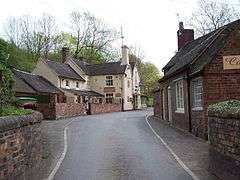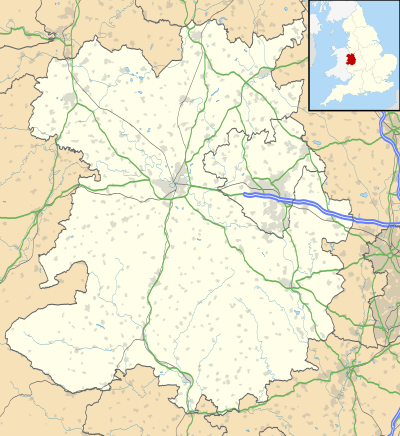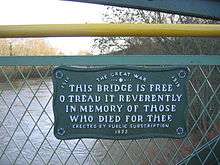Coalport
Coalport is a village in Shropshire, England. It is located on the River Severn in the Ironbridge Gorge, a mile downstream of Ironbridge. It lies predominantly on the north bank of the river; on the other side is Jackfield.
| Coalport | |
|---|---|
 Centre of the village, where the road crosses the Hay Inclined Plane, with the Shakespeare Inn | |
 Coalport Location within Shropshire | |
| OS grid reference | SJ696023 |
| Civil parish | |
| Unitary authority | |
| Ceremonial county | |
| Region | |
| Country | England |
| Sovereign state | United Kingdom |
| Post town | TELFORD |
| Postcode district | TF8 |
| Dialling code | 01952 |
| Police | West Mercia |
| Fire | Shropshire |
| Ambulance | West Midlands |
| UK Parliament | |
The settlement was planned as a canal–river interchange and a complete "new town" by ironmaster William Reynolds, who between 1788 and 1796 built warehouses, workshops, factories and workers accommodation in Coalport. He also directed the construction of the Shropshire Canal, linking the East Shropshire Coalfield with the River Severn — the terminus being Coalport Wharf between the Brewery Inn and Coalport Bridge. Coalport at this time was much larger than it is today.
It forms part of the civil parish of the Gorge and is the southeastern corner of the borough of Telford and Wrekin.
Cast iron bridge
The Coalport Bridge of cast iron was built in 1818 and unlike its even more famous neighbour at Ironbridge, still takes vehicular traffic, albeit limited to a single line of traffic, a 3-tonne weight limit and a height restriction of 6 ft 6in (1.98 m). It was restored and strengthened in 2004. The bridge links Coalport with Broseley, a small town approximately a mile (1.6 km) away.
The bridge effectively extends Coalport across the river to an area historically known as Preens Eddy. On this southern side of the bridge is the Woodbridge Inn and the former Coalport West railway station. The Telford and Wrekin borough boundary runs through Preens Eddy - the Woodbridge Inn for instance lies in the Shropshire Council area.
Pottery
Coalport was home to an important pottery founded in 1795 by John Rose. It produced Coalport porcelain which became popular worldwide. The building it was initially produced in is now a youth hostel and café. Production later moved across the canal to the buildings which are now the Coalport China Museum. Production moved to Staffordshire in 1926, and, although the Coalport name was retained as a brand, the company subsequently became part of the world-famous Wedgwood group.
Railways
The easternmost part of Coalport was, at one time, served by two railway stations. Coalport East (LNWR) was a terminus of a branch from Wellington on the northern river bank. Coalport West (GWR) was a through station on the Severn Valley Railway on the other, southern bank (now part of the Severn Way waymarked walk). The station building is a private residence. Two converted ex-British Railways coaches have been placed between the platforms to provide holiday accommodation.
Tar tunnel
The Tar Tunnel, a former source of natural bitumen, is near the Coalport Canal, and is open to the public at certain times.
Memorial footbridge

The Memorial Bridge is a footbridge spanning the River Severn, linking Coalport with Jackfield. It was built with funds raised by public subscription in 1922, and is in memorial to those who died in the First World War.
Canal
The Coalport Canal runs through the village and greatly aided the settlement's development. The Hay Inclined Plane was completed in 1793 and is one of the country's major industrial monuments and the best preserved and most spectacular of its kind. It enabled canal barges and narrowboats to be transferred from the bottom of the Severn gorge to the top, up a 1 in 4 gradient on wheeled cradles, operated by a team of just four men. It was the equivalent of 27 canal locks and could transport six barges per hour in this fashion, an operation that would have taken over three hours using a traditional lock system. The canal was eventually superseded by rail transport and fell into neglect, silting up and becoming overgrown and was infilled in the 1920s. It was not until the late 1970s that it was partially restored, with further restoration in the 1990s. The Hay Inclined Plane is now part of the Blists Hill museum, part of the Ironbridge Gorge Museum Trust that operates Blists Hill Victorian Town, just half a mile up the hill.
Pubs
There are four public houses open in Coalport — the Brewery Inn, the Shakespeare Inn, the Boat Inn and the Woodbridge Inn (on the southern bank, by Coalport Bridge).[1]
See also
- Industrial revolution
- Ironbridge Gorge Museum Trust
- The Iron Bridge
- Listed buildings in The Gorge
Bibliography
- Cossons, Neil; Trinder, Barrie (2002). The Iron Bridge: Symbol of the Industrial Revolution (2 ed.). Phillimore & Co Ltd.
- Cragg, Roger (Editor) (1997). Civil Engineering Heritage: Wales and West England (2 ed.). Thomas Telford Ltd.CS1 maint: extra text: authors list (link)
- Lewis, Peter R. (2007). Disaster on the Dee: Robert Stephenson's Nemesis of 1847. Tempus.
References
- Shropshire Pub Survey Coalport pubs
